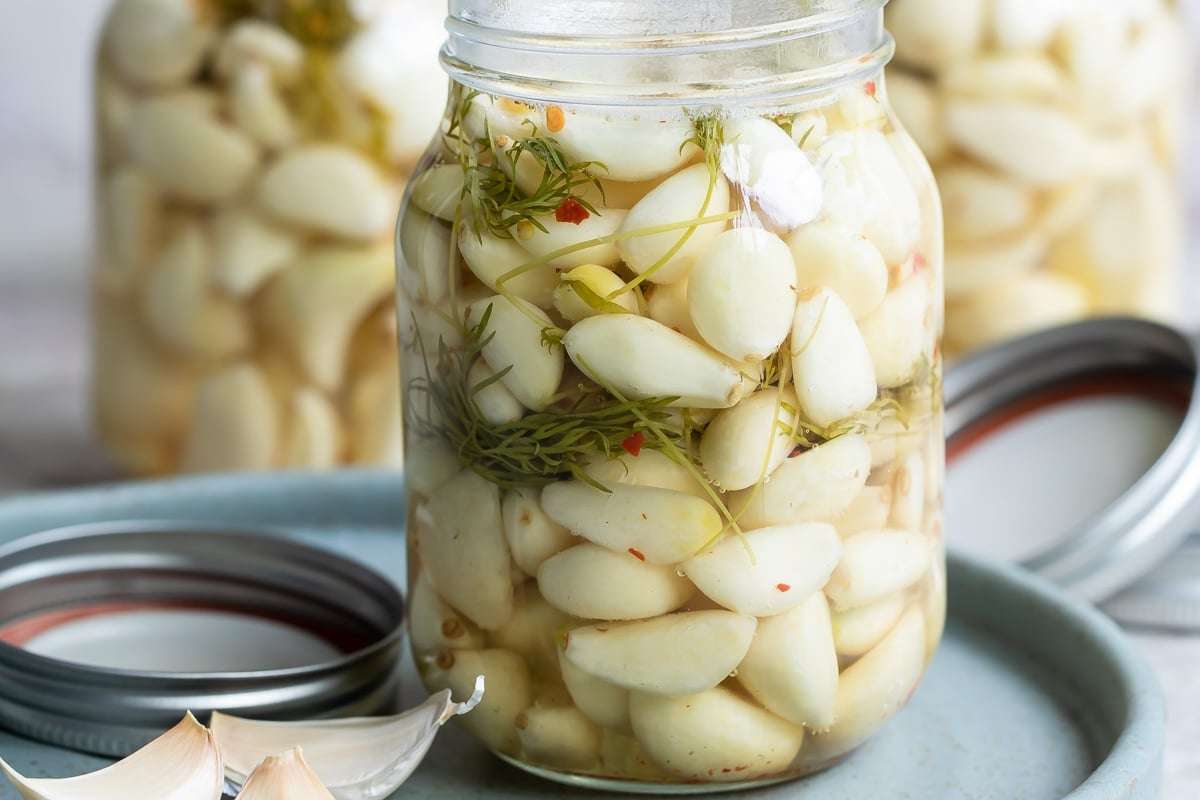
Pickled Garlic
This recipe is not suitable for shelf-stable canning. If you make this recipe, you MUST store it in the refrigerator. Even if you seal the jars with a water bath. Refrigerate!
Ingredients
- 1/4 cup canning salt
- 5 cups white vinegar
- 2 pounds fresh garlic peeled
- 1 teaspoon red chili flakes
- 4 heads fresh dill or 2 cups fresh dill, stems and leaves coarsely chopped
Instructions
- Combine canning salt and vinegar in a large saucepan. Bring to boil; reduce heat and simmer 10 minutes (180 degrees).
- Meanwhile, pack garlic into 4 sterilized pint jars (about 8 ounces per jar) leaving 1/2-inch of headspace. Add 1/4 teaspoon red pepper flakes and 1 head of dill to each jar. (If using fresh dill, add 1/2 cup to each jar.)
- Using a ladle, divide hot pickling liquid between the 4 jars, leaving 1/2-inch of headspace. Remove air bubbles, clean jar rims, center lids on jars, and adjust band to fingertip-tight.
- Chill in the refrigerator until pickled as desired (I recommend at least 3 weeks in the refrigerator). Store in refrigerator for up to 4 months (see notes) or seal jars following the instructions below (the pickled garlic must still be refrigerated; it will not be shelf-stable).
To seal jars (MUST BE REFRIGERATED, NOT SHELF-STABLE):
- Process jars in boiling water for 10 minutes. The jars must be covered by at least 1 inch of water. Turn off heat and remove cover. Let jars cool 5 minutes. Cool 12 hours. Check seals. Chill in the refrigerator until pickled as desired (I recommend at least 3 weeks in the refrigerator). Store in refrigerator for up to 4 months (see notes).
Notes
- WARNING: This recipe is not suitable for shelf-stable canning. Obviously people (or companies) sell shelf-stable pickled garlic, but I am not an expert in this area and garlic has a propensity to develop botulism. So, if you make this recipe, you MUST store it in the refrigerator. Even if you seal the jars with a water bath. Refrigerate! "Canning of garlic is not recommended. Garlic is a low-acid vegetable that requires a pressure canner to be properly processed. Garlic loses most of its flavor when heated in this way. For this reason, adequate processing times have not been determined for canning garlic."
- Yield: This recipe makes 4 pints (8 cups), enough for 32 servings, 1/4 cup each.
- Storage: The National Center for Home Food Preservation states that the garlic and vinegar mixture may be refrigerated for up to 4 months. It's safe to use the flavored liquid for other things. Discard if you see any signs of mold or yeast growth.
Blue garlic: Sometimes pickled garlic turns blue or turquoise when you pickle it. It’s completely normal and still safe to eat and you don’t need to worry. You can read all about the chemistry of garlic (and exactly why it may or may not turn blue). To prevent the bluish color:
User kosher salt or sea salt to avoid iodine Use stainless steel or enamel cookware and utensils (avoid copper, aluminum, cast iron, and tin cookware and utensils) Reduce chlorophyll production by avoiding sunlight Use distilled water to avoid the trace minerals found in tap water.
- User kosher salt or sea salt to avoid iodine
- Use stainless steel or enamel cookware and utensils (avoid copper, aluminum, cast iron, and tin cookware and utensils)
- Reduce chlorophyll production by avoiding sunlight
- Use distilled water to avoid the trace minerals found in tap water.
Nutrition Information
Nutrition Facts
Serving: 32servings (1/4 cup each)
Amount Per Serving
Calories 52
% Daily Value*
| Serving | 0.25cup | |
| Calories | 52kcal | 3% |
| Carbohydrates | 10g | 3% |
| Protein | 2g | 4% |
| Fat | 1g | 2% |
| Saturated Fat | 1g | 5% |
| Sodium | 7mg | 0% |
| Potassium | 124mg | 3% |
| Fiber | 1g | 4% |
| Sugar | 1g | 2% |
| Vitamin A | 35IU | 1% |
| Vitamin C | 9mg | 10% |
| Calcium | 59mg | 6% |
| Iron | 1mg | 6% |
* Percent Daily Values are based on a 2,000 calorie diet.